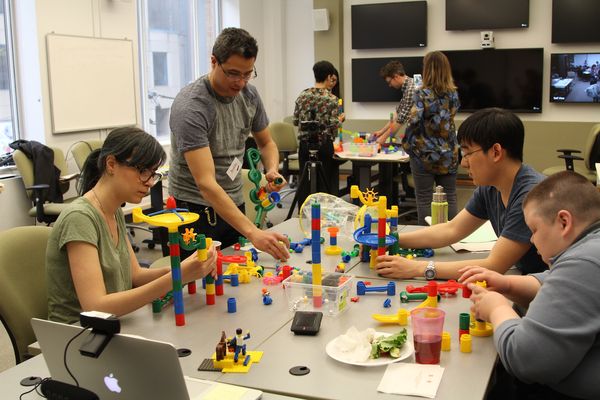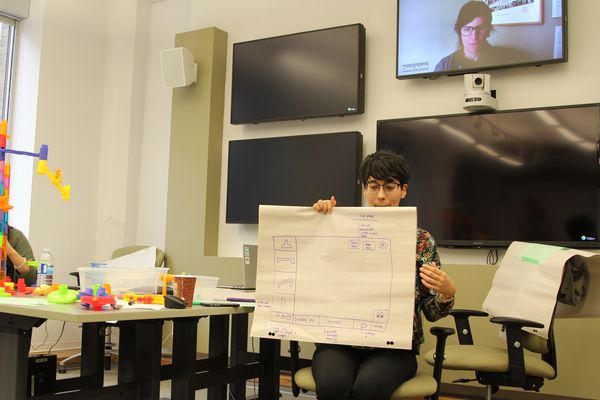Create-a-Thon
A Create-a-Thon (CaT) brings together a diverse group of people in order to collaboratively contribute to the collective design of a system, product or service. A CaT may also be considered as a form of collective creativity or participatory design, all of which are fundamentally processes that include both the expertise of system/product/service designers and the situated expertise of users—those impacted by change to or creation of new systems, products and services (Sanders and Stappers). Integral to a CaT is the meaningful involvement of a diverse group of participants, including individuals whose needs aren’t met (who find a product or service impossible or difficult to use), as well as people whose insights are not typically represented elsewhere because they do not fit into a construct of “typical”, “average”, or the envisioned “target audience”.
The main objectives of holding a CaT event are:
- Work together to identify problems in a given context
- Generate ideas and personal stories
- Inform the design of systems, products and/or services with generated ideas and stories
To avoid the burden or influence of prior project decisions or inherent biases, the structure of the CaT should aim to create an open and inviting environment where non-expert participants can contribute fully and equitably. This can be accomplished by designing the event with the standpoint that a variety of expertise, ability, cultural and socio-economic statuses contribute unique perspectives and ultimately build better outcomes. To fully practice inclusive design, Create-a-Thons can be applied at several points throughout a design process, and not simply at the beginning.
Figure 1: A group collaborates together to build a marble track based on some basic requirements.
CaT Principle: design by metaphor
A Create-a-Thon employs “Design by Metaphor” which is the process of designing using a different but conceptually similar artifact, topic, or domain. This method allows the project to be abstracted and simplified which enables participants to more easily collaborate on new ideas and stories. This collection of ideas and stories are then distilled and translated into new designs and ideas for the intended project. Collaboratively building using this abstracted and simplified space enables participants to discover connections between different contexts that wouldn’t otherwise be possible. “Designing by metaphor” gives equal footing to participants by staying away from the design history, technical complexities and biases associated with current solutions relevant to a project.
In the process of “designing by metaphor”, participants describe the co-design artifact to each other, mediate for those with different perceptual abilities, and negotiate how it should get done. The main objective of this collaborative activity is to map ideas from one object to another one in a different context, and in doing so, develop creative and unexpected design approaches.
CaT Principle: stories as outcomes
Participant stories generated at a Create-a-Thon are a collection of perspectives that can contribute to robust and agile design solutions. It is important to avoid reductive practices of information analysis; avoid distilling stories to a collection of averages and eliminating individual differences in favour of sameness. Collecting and applying participant stories aims to counterbalance representations — such as personas — with the the understanding that individual stories don’t represent the voice of the user, they are the voice of the user. Therefore, participant stories are fundamental to the practices of collaboration and inclusive design.
CaT among other design activities
Although CaTs share similarities with other participatory design approaches, such as hackathons, design jams, and design charrettes, it has its unique structure and appeals to a broader and more diverse group of people. Hackathons commonly bring together the “technical” end of the spectrum either by focusing on digitally-based design solutions or engineering physical artifacts. Design jams and design charrettes mostly engage designers, architects, planners and people with related design expertise to work on designing of the products, services or built environment. CaTs, on the other hand, aim to be broader than a traditional Hackathon or a design jam. CaTs encompass all forms of design mediums (industrial, interior, graphic and digital) and seek to generate ideas and stories that inform the shape of a solution rather than attempting to create a solution or an artifact itself. The CaT structure also encourages removing the line between the experts and non-experts, allows everyone to participate equally, and considers each individual contribution as important as the others.
Figure 2: A participant shares their group’s design after being given the task of creating a software version of the physical marble track toy.
Designing a CaT
Step 1: Define a broad problem space
Encourage creative thinking by having a broad problem space. Broad problem spaces can generate more robust solutions and new possibilities (serendipitous discovery and virtuous cycles). A more general problem space would also appeal to the diverse group of collaborators as specific expertise, domain knowledge, or ability is not required.
Step 2: Add structure to facilitate exploration
Developing activities and scenarios will add structure to help focus and direct participants during a CaT. Without structure the process will be chaotic and confusing for participants. Use scenarios for context to aid the creative process.
The number of activities and scenarios to include in your event will be informed by the problem, the number of participants, and the available time. Conduct dry runs of the activities and scenarios to strike the right balance between collaboration, reflection, and fun.
Creating scenarios and activities:
- Consider activities where knowledge or ability does not give some participants a significant advantage. Be sensitive to possible participant dynamics influenced by experience, expertise, or ability.
- Encourage collaboration and discovery by having activities that are mutually unfamiliar to most participants .
- Emphasize the creation of both personal and collaborative stories, insights, and perspectives, instead of mastery of the task or activity.
- Consider activities that are simple enough so the knowledge gap between a design novice and expert can be addressed with minimal effort.
- Provide multiple opportunities for individuals and groups to iterate ideas over the course of the event. This can lead to interesting moments where ideas change and get refined. Multiple iterations can also alleviate anxiety over the creative process.
Step 3: Include participants from “edge-to-edge”
Aim for participation from a broad audience not just the people who fit the contextual definition of “average” or from your “target demographic”. Find participants from a spectrum of ages, gender, vocation, cultures, ability, and other differences. Intentionally including participants “from the edges” results in a rich variety of perspectives to draw from at all stages of a project. Diversity of perspective often leads to more innovative and creative solutions.
Step 4: Provide multiple opportunities and methods of expression
To capture a variety of perspectives through individual stories, offer multiple opportunities for individual and collaborative reflection and documentation during the event. These opportunities can help individuals refine, elaborate, or evolve their thoughts as they interact and discuss with others while progressing through the activity.
Include different tools for self documentation to allow participants a variety of ways to express their ideas in multiple modalities (Reference: “Communicate Multimodally” on the Inclusive Design Guide).
Examples of different tools include:
- Stationary of different sizes, styles, and colours
- Reusable drawing boards like white boards, or sketch pads
- Craft and building materials like plasticine, Lego blocks and other construction sets
- Voice recorders, voice-to-text, text-to-speech
- Post-it notes
- Laptops / tablets
Step 5: Preserving stories post-event
Preserving the participant’s thoughts and perspectives can help with making design decisions, formulate new ideas, and gives you insights into further design activities. These stories can also be referenced throughout the project as a touchstone for future design decisions and inspiration.
Bibliography
- Sanders, Elizabeth B.-N, and Pieter Jan Stappers. Convivial Design Toolbox. Amsterdam: BIS, 2014.
- guide.inclusivedesign.ca. (2017). Welcome to The Inclusive Design Guide | Inclusive Design Guides. [online] Available at: https://guide.inclusivedesign.ca/index.html [Accessed 26 Sep. 2017].

